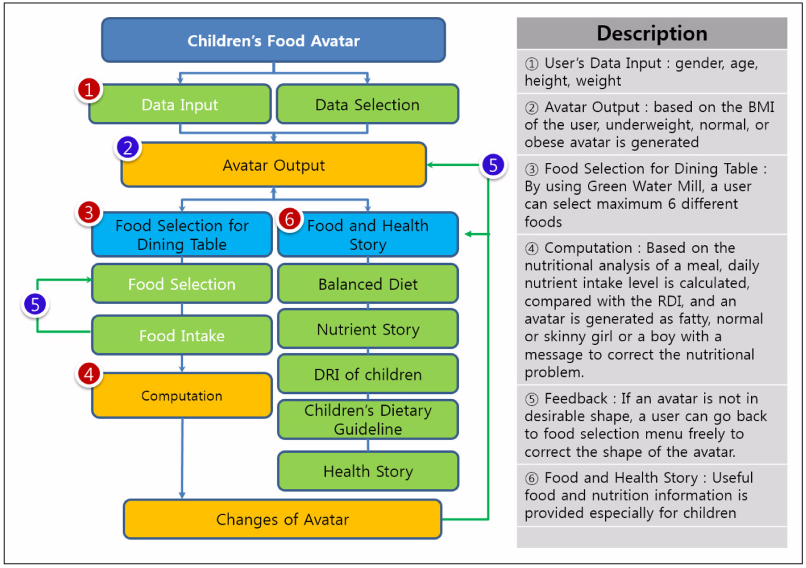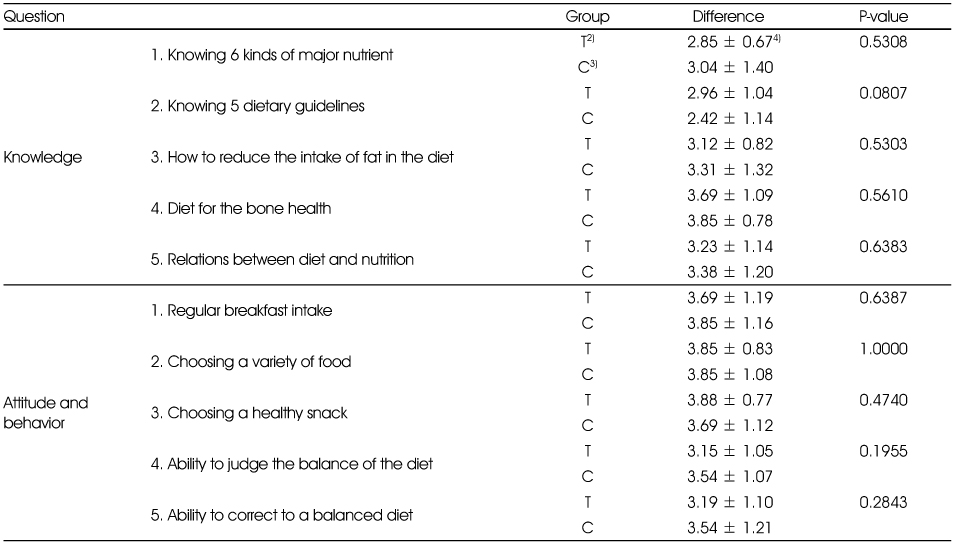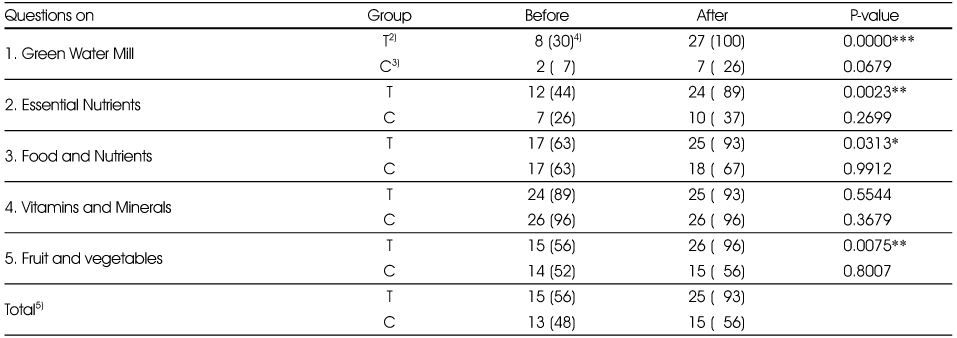Articles
- Page Path
- HOME > Korean J Community Nutr > Volume 18(4); 2013 > Article
-
Original Article
- Development of 'Children's Food Avatar' Application for Dietary Education
- Joo-Han Cho, Sook-Bae Kim, Soon-Kyung Kim, Mi-Hyun Kim, Gap-Soo Kim, Se-Na Kim, So-Young Kim, Jeong-Weon Kim
-
Korean Journal of Community Nutrition 2013;18(4):299-311.
DOI: https://doi.org/10.5720/kjcn.2013.18.4.299
Published online: August 31, 2013
Major of Elementary Science & Technology Education for Life, Graduate School of Seoul National University of Education, Seoul, Korea.
1Department of Food Science & Human Nutrition, Chonbuk National University, Jeonju, Korea.
2Department of Food Sciences & Nutrition, Soonchunhyang University, Asan, Korea.
3Department of Food and Nutrition, Kangwon National University, Samcheok, Korea.
4Department of Computer Education, Seoul National University of Education, Seoul, Korea.
5Department of Agrofood Resources, National Academy of Agricultural Sciences, RDA, Suwon, Korea.
6Department of Science & Technology Education for Life, Seoul National University of Education, Seoul, Korea.
- Corresponding author: Jeong-Weon Kim, Department of Science & Technology Education for Life, Seoul National University of Education, Seochojoongang-ro 96, Seocho-gu, Seoul 137-742, Korea. Tel: (02) 3475-2516, Fax: (02) 3475-2263, kimjwe@snue.ac.kr
Copyright © 2013 The Korean Society of Community Nutrition
This is an Open-Access article distributed under the terms of the Creative Commons Attribution Non-Commercial License (http://creativecommons.org/licenses/by-nc/3.0/) which permits unrestricted non-commercial use, distribution, and reproduction in any medium, provided the original work is properly cited.
- 686 Views
- 0 Download
- 4 Crossref
Figure & Data
REFERENCES
Citations

- A Qualitative Study on the Potential Utilization of a Mobile Phone for Obesity Management in Elementary-School Children : Parents Perspective
Bo Young Lee, Mi-Young Park, Kirang Kim, Jea Eun Shim, Ji-Yun Hwang
Korean Journal of Community Nutrition.2019; 24(2): 117. CrossRef - Effects of Nutrition Education Using Dietary Guidebook in Higher Grade Elementary Students of Jeonbuk Area
Mi-Ran Park, Sook-Bae Kim
Korean Journal of Community Nutrition.2018; 23(1): 13. CrossRef - Development of Education Materials as a Card News Format for Nutrition Management of Pregnant and Lactating Women
Young-Hee Han, Jung Hyun Kim, Min Jun Lee, Taeksang Yoo, Taisun Hyun
Korean Journal of Community Nutrition.2017; 22(3): 248. CrossRef - A study on Consumer's Needs for Development of Diet Guide Application for Pregnant Women
Sook-Bae Kim, Jeong-Weon Kim, Mi-Hyun Kim, Young-Sook Cho, Se-Na Kim, Hee-Sook Lim, Soon-Kyung Kim
Korean Journal of Community Nutrition.2013; 18(6): 588. CrossRef




Fig. 1
Fig. 2
Fig. 3
Fig. 4
Developing stages of the App by ADDIE model
The ADDIE model : The five phases-Analysis, Design, Development, Implementation, and Evaluation-represent a dynamic, flexible guideline for building effective training and performance support tools
Core elements for the development of the App contents
Contents of the classroom education by using developed App
Comparison of the levels of knowledge, attitude and behavior of treatment and control groups before using the App1)
1) 5-point Likert scale questions: 1 for strongly disagree, 2 for disagree, 3 for neutral, 4 for agree, and 5 for strongly agree
2) T: Treatment group (n = 27)
3) C: Control group (n = 27)
4) Mean ± SD
Comparison of the treatment and control groups with regard to the scores of correct answers on nutritional knowledge before and after using the App1)
1) Multiple choice questions
2) T: Treatment group (n = 27)
3) C: Control group (n = 27)
4) N (%)
5) Mean
*: p < 0.05, **: p < 0.01, ***: p < 0.001
Changes of nutritional knowledge, attitude and behavior in the treatment group of the App1)
1) 5-point Likert scale questions: 1 for strongly disagree, 2 for disagree, 3 for neutral, 4 for agree, and 5 for strongly agree
2) n = 27
3) p-value of the t-test
*: p < 0.05, **: p < 0.01, ***: p < 0.001
Comparison of the levels of knowledge, attitude and behavior of treatment and control groups after using the App1)
1) 5-point Likert scale questions: 1 for strongly disagree, 2 for disagree, 3 for neutral, 4 for agree, and 5 for strongly agree
2) T: Treatment group (n = 27)
3) C: Control group (n = 27)
4) Mean ± SD
*: p < 0.05, **: p < 0.01 by independent samples t-test
Satisfaction levels of children and elementary teachers for the App
1) N (%)
The ADDIE model : The five phases-Analysis, Design, Development, Implementation, and Evaluation-represent a dynamic, flexible guideline for building effective training and performance support tools
1) 5-point Likert scale questions: 1 for strongly disagree, 2 for disagree, 3 for neutral, 4 for agree, and 5 for strongly agree 2) T: Treatment group (n = 27) 3) C: Control group (n = 27) 4) Mean ± SD
1) Multiple choice questions 2) T: Treatment group (n = 27) 3) C: Control group (n = 27) 4) N (%) 5) Mean *: p < 0.05, **: p < 0.01, ***: p < 0.001
1) 5-point Likert scale questions: 1 for strongly disagree, 2 for disagree, 3 for neutral, 4 for agree, and 5 for strongly agree 2) n = 27 3) p-value of the t-test *: p < 0.05, **: p < 0.01, ***: p < 0.001
1) 5-point Likert scale questions: 1 for strongly disagree, 2 for disagree, 3 for neutral, 4 for agree, and 5 for strongly agree 2) T: Treatment group (n = 27) 3) C: Control group (n = 27) 4) Mean ± SD *: p < 0.05, **: p < 0.01 by independent samples t-test
1) N (%)

 KSCN
KSCN












 PubReader
PubReader Cite
Cite


